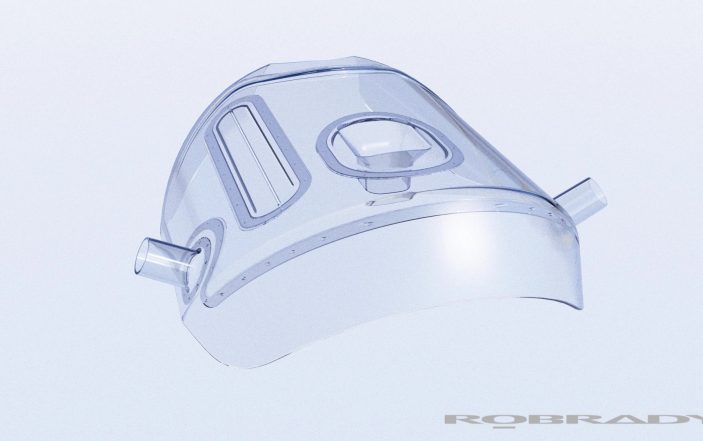Physicians devise shield to offer measure of relief from virus transmission.
***This article was written by one of EPM’s advertising partners as a promotional supplement.***
The global COVID-19 pandemic has changed the way we practice medicine. Seemingly overnight routine procedures that have been performed the same way for decades have become life-threatening encounters for medical personnel. Worldwide, over the past year, scores of nurses, doctors and ancillary staff have succumbed or become critically ill with COVID-19 as they cared for their patients on the front lines of this pandemic.
Shortness of breath is still one of the most common presenting conditions of patients presenting to emergency departments. While the causes of dyspnea include asthma, CHF, COPD, bacterial pneumonia and AMI, the initial therapies to treat these conditions including supplemental oxygen, nebulizer therapy, BIPAP/CPAP, and endotracheal intubation remains largely the same. All of these therapies place the provider in close proximity to the patient’s exhaled air, which may carry potentially lethal viruses.
The COVID-19 pandemic has thus caused many of these procedures to be so potentially dangerous to medical personnel that many hospitals, ambulance services and medical offices have banned or delayed the life-saving use of nebulizer therapy, BIPAP, and others due to the risk of exposure and infection.
Even with the advent of rapid COVID-19 testing, these tests often take one to four hours to return results. This delay in therapy causes direct harm to respiratory patients, regardless of the underlying cause of their shortness of breath. Even as most of these patients do not have COVID-19, they are still negatively affected to our response to potential infection.
But these kinds of problems are the exact situations where the innovation and out of the box thinking of emergency physicians shines the brightest. In the relatively small town of Branson, MO, a place some might only know as “the Las Vegas of the Midwest,” a small group of emergency physicians were working on the front lines of the pandemic.

Though Branson is only a few thousand residents, millions of visitors come to their nationally known tourist attractions each year, bringing all of their infections from home. Faced with the seemingly impossible task of meeting the appropriate isolation guidelines for such a large and diverse patient population in a small semi-rural hospital, these ER docs set out to provide a solution to this issue.
Researching the different solutions that had been attempted, including intubation boxes, plastic hoods, and other types of expensive PPE — that seemed more appropriate for larger institutions with larger budgets — they devised a direct to patient negative-pressure system that fits directly over the affected area. The negative pressure mask over the mask system allows supplemental oxygen administration, nebulizers, and even BIPAP/CPAP therapies without the risk of patient’s exhaled virus laden air being scattered all over the treatment room.
The Respiratory Shield PCS, resembling an oxygen or treatment mask, but slightly larger, simply clips onto the treatment mask and is equipped with negative pressure ports that are connected to a suction filter device utilizing HEPA/ULPA viral filter technology. Instead of having negative pressure rooms this technology follows current FDA recommendations to utilize negative pressure in virtually any possible room or situation, even the back of an ambulance. This technology can even be used in the preliminary workup of a patient under investigation for viral swab collection in a potential COVID-19 patient.
A slightly bigger variation on the theme of the Respiratory Shield PCS is the Endoshield PCS that covers the entire face, but has a central port allowing unimpeded videolaryngoscopy. The central port is flexible, allowing full movement and manipulation of the laryngoscope blade to obtain an optimal view.
The endotracheal tube is placed through an opening on the right side of the mask, with generous room for manipulation of the tube, suction or other devices. Negative pressure ports are then located on either side of the mask. Again, these easily connect to a vacuum utilizing HEPA or UPLA viral filter technology to remove aerosolized pathogens.

And while we hope that the COVID-19 pandemic will start to fade with the widespread use of vaccines, the world’s attention to infectious disease risk is not likely to ever go away. This technology provides protection not only for COVID-19, but also influenza, tuberculosis, common cold viruses and other aerosolized pathogens. The Endoshield PCS can be utilized for EGD, bronchoscopy and countless other procedures to enhance provider safety. Portable vacuums are options that are optimal for EMS applications, hospital code/rapid response carts, and mobile testing sites among others.
While there has been no large scale testing of these devices, the Shield PCS is has been requested for research by several academic facilities and preliminary results have been encouraging. Studies of potential viral dispersion using aerosolized gases have demonstrated near-complete capture, without effect on patient comfort or effectiveness of the procedure.
The idea is simply elegant. The results suggest that these devices are highly effective and versatile in many settings and applications. Leave it to a bunch of ER docs to build a better mouse trap.
More information is available at www.SafERmedicalproducts.com









